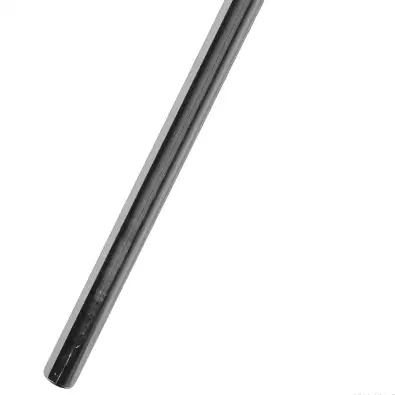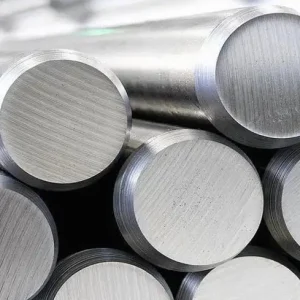Nimonic® Alloy 75 is a robust, solution-strengthened nickel-chromium superalloy that delivers excellent oxidation and scaling resistance with moderate high-temperature strength and very good fabricability; it is ideal for furnace parts, gas-turbine ancillary components and engineered sheet/plate applications where oxidation resistance and formability matter more than maximum creep strength.
What is NIMONIC® 75?
Nimonic 75 (UNS N06075; EN 2.4630 / 2.4951; trade names include Nimonic® 75, Alloy 75, Haynes® 75 in some sources) is a nickel-chromium base alloy originally developed in the 1940s for early jet-engine/turbine components. It is an “80/20” Ni–Cr family member with controlled titanium and carbon additions that provide modest strengthening and improved oxidation resistance. The alloy is primarily used in sheet, strip and forged forms for components that run hot in oxidizing atmospheres but do not require the highest creep/rupture strength of age-hardenable superalloys.
Chemical composition
The table below compiles commonly published composition ranges for Nimonic 75 and Nimonic 80A (wt. %). These are typical composition windows used by producers—always confirm with your supplier certificate (CoA) for a batch-specific analysis.
| Element | Nimonic 75 (typical wt.%) | Nimonic 80A (typical wt.%) |
|---|---|---|
| Nickel (Ni) | Balance (~≥70–78%) | Balance (~≥70–78%) |
| Chromium (Cr) | 18.0 – 21.0 | 18.0 – 21.0 |
| Iron (Fe) | ≤ 5.0 | ≤ 5.0 |
| Titanium (Ti) | 0.6 – 1.2 | 0.6 – 1.4 |
| Aluminium (Al) | trace–0.6 | 0.6 – 1.2 |
| Carbon (C) | 0.08 – 0.15 | 0.05 – 0.15 |
| Manganese (Mn) | ≤1.0 | ≤1.0 |
| Silicon (Si) | ≤1.0 | ≤1.0 |
| Copper (Cu) | trace | trace |
| Other (Co, Nb etc.) | trace levels | trace levels |
(Source: technical datasheets and manufacturer tables — ranges vary by mill/standard; use CoA to confirm.)
Note: the defining compositional difference for 80A versus 75 is the intentional aluminium addition to promote γ′ precipitation (with Ti), giving age-hardening capability and higher high-temperature strength.
Material properties
| Property | Typical value / range |
|---|---|
| Density | 8.37 g·cm⁻³ (8370 kg·m⁻³) |
| Melting range | ≈ 1340–1380 °C |
| Tensile strength (annealed) | ~700–850 MPa (published ranges vary by product form) |
| Yield strength (annealed) | ~285–445 MPa (depending on temp and form) |
| Elongation (in 50 mm) | ~30–40% (good ductility in annealed condition) |
| Hardness | Moderate; can be strain-hardened; Rockwell and BHN vary by temper. |
| Typical service temperature | up to ~600–700 °C for continuous service; short excursions higher. |
| Oxidation resistance | Excellent in oxidizing atmospheres up to ~1000 °C (surface scaling low compared to many steels). |
| Fabricability | Excellent formability and weldability when annealed — commonly used in sheet forming. |
Notes: published property values vary with supplier, product form (wire, sheet, bar) and heat treatment. Use manufacturer datasheets for final design limits; Special Metals/ATI/Haynes datasheets remain authoritative starting points.
Standards and designations
Common cross-references and standards you will see for this alloy:
-
UNS N06075 — universal (UNS) identifier.
-
EN / W.Nr. 2.4630 and 2.4951 — European material numbers reported in datasheets; EN designation often appears as NiCr20Ti.
-
Trade names / suppliers: Nimonic® 75 (Special Metals), Haynes® 75 (Haynes International / alternative formulation), ATI-75, Alloy 75, Nicrofer 7520 (some supplier labels). Always confirm the producer’s MTC and exact spec.
What is Nimonic 75 used for?
Because of its unique balance of oxidation resistance, reasonable high-temperature strength, and good formability, Nimonic 75 is typically chosen for:
-
Gas turbine ancillary parts (casings, shrouds, combustion supports) where oxidation scaling is a concern but ultimate creep strength is not the primary driver.
-
Industrial furnace components and heat-treatment fixtures where repeated exposure to oxidizing atmospheres and thermal cycling occurs.
-
Aerospace fabricated components (sheet-formed parts, fasteners in some niches) where welding and forming plus temperature resistance are needed.
-
Nuclear and laboratory high-temperature equipment requiring stable surfaces under long-term oxidation.
The alloy’s formability (sheet/strip) and weldability make it economical in manufacturing relative to age-hardenable superalloys that often need complex heat treatments.
What is equivalent to NIMONIC 75?
Exact “equivalents” depend on which property matters (chemistry, tensile, oxidation). Typical equivalents or close matches you will encounter:
-
Haynes® 75 / ATI-75 / Alloy 75 — commercially comparable compositions and performance in datasheets.
-
EN NiCr20Ti / 2.4630 — the European designation often used for engineering procurement.
-
Some references compare Nimonic 75 to Alloy 600 in certain oxidation aspects, but Nimonic 75 has Ti and slightly different balance, so substitution requires care.
Buyer guidance: don’t assume interchangeability without checking the controlling code (UNS/EN), mechanical property requirements and any heat-treatment/aging constraints for your component.
Heat treatment, forming and welding
Annealing / solution treatment: common practice is ~1050–1052 °C for short soak times (sheet: 5–10 min; bar: 30–60 min) then air cooling — this produces an annealed, ductile condition recommended before forming and welding.
Hot working ranges: ~1220–950 °C (recommended hot-work window) with appropriate cooling/quenching depending on downstream processing.
Cold working / hardening: the alloy work-hardens; many strength increases are achieved by cold deformation rather than precipitation hardening. Spring temper may be achieved through cold work plus stress relief (typical stress-relief ~450–470 °C for 0.5–1 hr).
Welding: weldable with common Ni-based filler metals when the parent is annealed; parts are normally annealed before welding to avoid cracking from prior cold work. Use matching filler and follow qualified welding procedures for service temperature and pressure requirements.
Inspection notes: watch for grain growth during high-temperature cycles and for any carburisation/scale on surfaces operating in contaminated atmospheres — post-weld heat treatment and chemical analysis of critical lots is recommended.
Practical difference: Nimonic 75 vs Nimonic 80A
Both are members of the Nimonic family but differ in emphasis:
-
Nimonic 75: solution-strengthened Ni–Cr with Ti/C additions; emphasizes oxidation resistance, formability and moderate strength up to ~600–700 °C. Good for sheet parts and furnace applications.
-
Nimonic 80A: typically higher strength and creep resistance due to different chemistry (higher Al/Ti or other strengthening elements in certain variants) and sometimes heat-treatable features; better where higher long-term stress at elevated temperatures is required but with somewhat reduced ductility/formability.
In procurement, pick 75 for oxidation + formability, pick 80A if the component needs higher sustained load capability at elevated temperature. For critical parts, compare creep-rupture data from supplier datasheets rather than nominal composition alone.
Nimonic 75 common product forms, sizes & weight
Below are typical forms and representative weights calculated from density 8.37 g/cm³ (8370 kg/m³). Use these to estimate shipping weight or to convert price/kg into per-piece costs.
Round bar — weight per metre (kg/m)
| Diameter (mm) | Weight (kg/m) |
|---|---|
| 6 | 0.2367 |
| 10 | 0.6574 |
| 12 | 0.9466 |
| 16 | 1.6829 |
| 20 | 2.6295 |
| 25 | 4.1086 |
| 32 | 6.7316 |
| 40 | 10.5181 |
| 50 | 16.4345 |
| 60 | 23.6656 |
| 80 | 42.0722 |
| 100 | 65.7378 |
(calculated using density 8.37 g/cm³ — values rounded) — source density reference.
Sheet / plate — weight per m² by thickness
| Thickness (mm) | Weight per m² (kg) |
|---|---|
| 0.5 | 4.185 |
| 1.0 | 8.370 |
| 1.5 | 12.555 |
| 2.0 | 16.740 |
| 3.0 | 25.110 |
| 4.0 | 33.480 |
| 6.0 | 50.220 |
| 8.0 | 66.960 |
| 10.0 | 83.700 |
(Useful for converting sheet-price per kg into sheet price per m²). Density source cited.
2025 Global price comparison
Pricing for specialty nickel alloys moves frequently (raw nickel market, alloy surcharges, inventories, MOQs and form all matter). The table below compiles recent supplier and market reports (ranges reflect typical FOB or supplier quoted ranges in 2024–2025 for common product forms; use these only for ballpark procurement planning — request current quotes for firm ordering).
| Region | Typical range (USD/kg) | Notes / sources |
|---|---|---|
| USA (domestic supply) | ~$28 – $90 / kg (form-dependent; bars and small industrial lots at higher end) | Domestic aerospace/qualified material and small quantities cost more. |
| Europe | ~$35 – $92 / kg (higher if certified aerospace / low-ppm impurities) | Tighter spec and testing can push price up. |
| China (FOB / trading) | ~$15 – $80 / kg (wide spread: commodity trading postings show competitive low-end offers but qualified/heat-treated material at higher levels). | Many suppliers list low MOQ prices; verify MTC and traceability. |
| Distributor online lists / recent market posts | sheet/bar: $28–$48 / kg; premium aerospace bars $70–$100+ / kg. |
What drives the spread: lot size, form (wire/plate/bar), certification (aerospace/NDT/MTC), surface finish, and current nickel metal surcharge. The low figures on marketplace pages often reflect unqualified stock lots; for critical components insist on material certificates and process records.
Procurement and inspection advice
-
Always specify the exact designation (UNS N06075 / EN 2.4630 or the supplier brand) plus required mechanical property values and heat treatment. Generic names invite mismatches.
-
Request full MTC (mill test certificate) showing chemical analysis and heat number traceability. Confirm Ti and C are within the envelope you expect.
-
If the part is safety-critical, require creep/rupture or stress-rupture data from the mill for the intended temperature/time point. Suppliers sometimes supply only room-temperature tensile data by default.
-
Beware low-MOQ online offers: many China marketplace listings show very low per-kg prices but lack certified heat treatment or traceability. Always verify factory capability and inspection records.
-
Specify surface finish and scaling limits if the application is a high-temperature oxidizing service — some fabricators recommend protective atmospheres or coating if cyclic oxidation is severe.
FAQs
1. What is Nimonic 75 mainly used for?
Sheet/plate and fabricated components in gas turbines, industrial furnaces and heat-treatment equipment where oxidation resistance and formability are priorities.
2. Is Nimonic 75 weldable?
Yes, when annealed, it is weldable with suitable nickel-based filler metals and qualified procedures. Post-weld anneal may be recommended for some applications.
3. What are the maximum continuous service temperatures?
Service ranges are typically up to ~600–700 °C for continuous service; brief excursions higher are possible depending on loading and environment.
4. Can it be heat-treated for additional strength?
Nimonic 75 is primarily solution-strengthened and frequently strengthened by cold work; it is not an age-hardenable alloy in the same way as some other Nimonic grades.
5. What is the chemical composition?
Ni balance; Cr 18–21%; Ti 0.2–0.6%; C 0.08–0.15%; Fe ≤5%; Si, Mn ≤1% each; Cu ≤0.5%. Confirm with MTC.
6. Is Nimonic 75 the same as Nimonic 80A?
No, 80A generally provides higher creep/strength at elevated temperatures; 75 favors formability and oxidation resistance. Choose based on required mechanical/cyclic life.
7. How should stock be specified for procurement?
State UNS/EN designation, product form, heat treatment condition, required mechanical properties, MTC level and any NDT requirement.
8. Typical density?
8.37 g/cm³ (≈ 8370 kg/m³). Useful for weight and cost conversions.
9. Can Nimonic 75 be cold-formed?
Yes — in annealed condition it forms well, but it work-hardens quickly; plan intermediate anneals for heavy forming.
10. Is it economical?
Relative to high-strength, age-hardenable superalloys, Nimonic 75 is cost-effective for oxidation-sensitive sheet/formed parts; however, it's a specialty nickel alloy so cost per kg remains significantly higher than steels. Market prices vary widely by region and certification.





